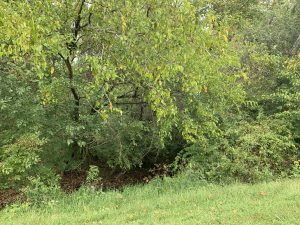
My sit spot view.
My sit spot is diagonally behind the Tayloe Fitness center, in front of the parking spaces on West Campus Drive, and is approximately 35 ft from Oyster Pond. To be super specific my literal sit spot is about 24 steps from the edge of Carvin’s Creek. During the 15 minute quiet observation time I didn’t see quite as much as I did last time. I noticed more Monarch’s passing by, more insects flying around my sit spot area, and more decomposition of the leaves that are feeding into Carvin’s Creek. Unfortunately during this visit I wasn’t able to see the crane.
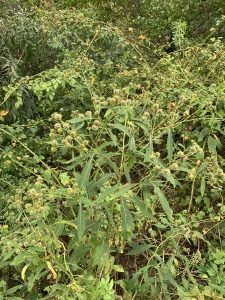
Green-Headed Coneflower with no yellow petals.
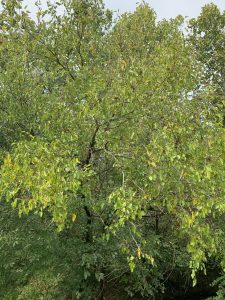
My second object with yellowing leaves.
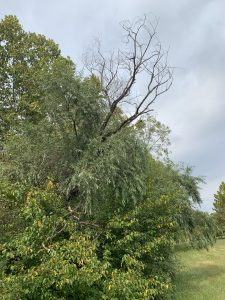
My third object showing no change.
For my 3 “things” I am following, I only noticed a major difference in my first object. My first object I was able to identify for my species summary and it is called the Green-Headed Coneflower. Last time I noted that the Green-Headed Coneflower’s leaves “grew” down but it turns out that it was wilting. This visit the petals were completely gone. I’m assuming the flower closed because there were no petals on the ground around the plant itself. The leaves are pretty much the same except for the increasing amount of consumed leaves. For my second object, the tree with curled looking leaves, I noticed that more leaves are continuing to yellow or grow more brown spots. I also noticed lichen growing on the branches so I will be sure to keep note on that as the season changes. My third object, the tree with dark bark and light green leaves, shows no change at all.
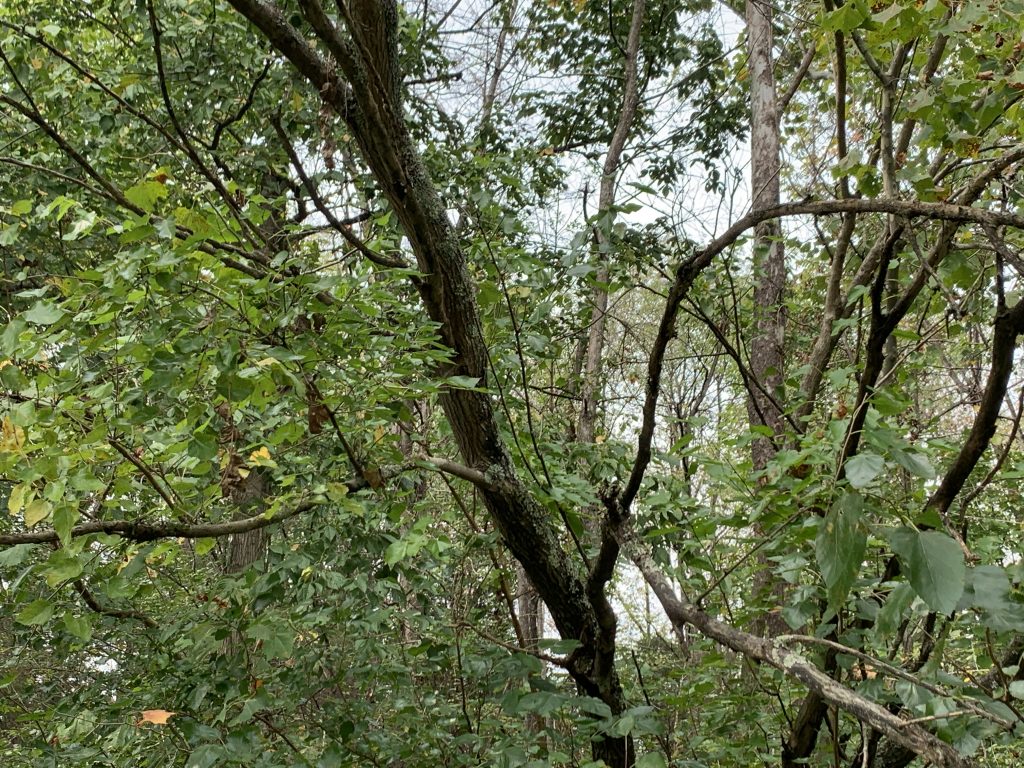
Lichen on branches of my second object.
During the time we were able to explore our site, I decided to focus on the creek itself, the lichen on the branch, and the lack of flowers on the Green-Headed coneflower. Since I don’t normally look down into the creek during visits I decided this would be a great time to look and see what’s going on down there. I saw that there is a riffle in the area I observe and I could actually hear the water moving when I couldn’t before. I also got to look at the pebbles and dead leaves flowing in the water which was interesting. I found the lichen on the tree while moving around and observing my sit spot area and decided to examine it more. Lichen don’t have a parasitic relationship to trees but the color and growth pattern of the lichen interested me and I’d like to document the change of it as the semester continues. While creating my species summary last week, I found another Green-Headed coneflower plant and while moving around I found more of these plants who also lost their petals/closed or looked very wilted. Without moving around I wouldn’t have noticed the other plants and the bad shape they all seemed to be in.
It was honestly weird to walk around my site and further examine things because I didn’t notice a lot of the other plants and trees surrounding the creek. I sort of focused on one area and didn’t try to look around so I probably wouldn’t have explored on my own. I feel like if I just stick to knowing and focusing on my spot specifically I could see any change that occurs in the area. I’m not normally a curious person when it comes to nature I just stick to what I’m assigned to.
The frist adaptation I observed was the reduction in petals of the Green-Headed Coneflower because of water scarcity. The plant last week began to wilt badly, so removing less areas to provide water to will help with conserving the little water the plant has. This could also be an adaptation to the hot temperatures we’ve been experiencing, less area to attract heat or lose water to. The second adaptation I observed was monarch migration because of the Northern winters that are coming soon. To avoid unwanted weather conditions, monarchs migrate to warmer places where they can thrive. The third adaptation I observed was with my second object. To avoid competition for sunlight and water, my tree grew towards the side of Carvins creek that I sit at so it can be in direct sunlight and get rain easier. The base of the tree is growing on the opposite side of the creek but the top canopy is on the other side which enables it to get better resources. I also noticed that some of the trees surrounding the creek had roots that grew down into the creek which could be due to erosion over time but it could also be a response to a decreased water supply so they adapt their roots to grow to sources of water. It was hard at first to think of three adaptations because I don’t think of reasons as to why things do what they do, but once I thought about examples from class some of the things I observed became apparent. *two adaptations that I discussed are displayed in the above pictures*
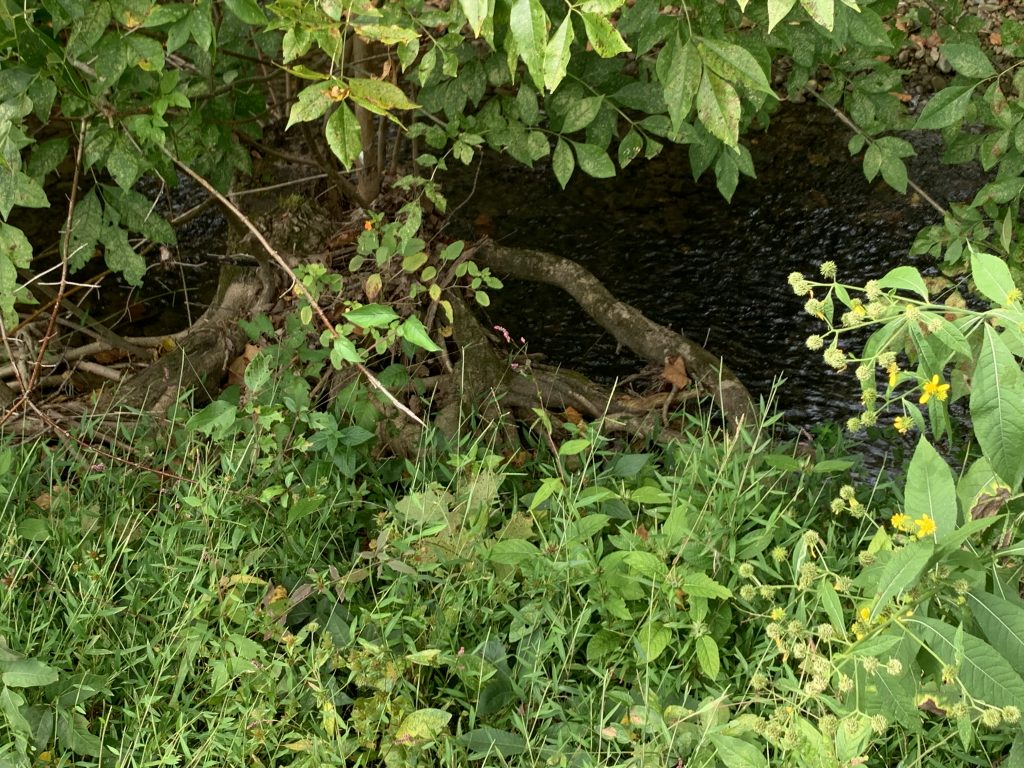
Roots of a tree growing down into Carvins Creek.


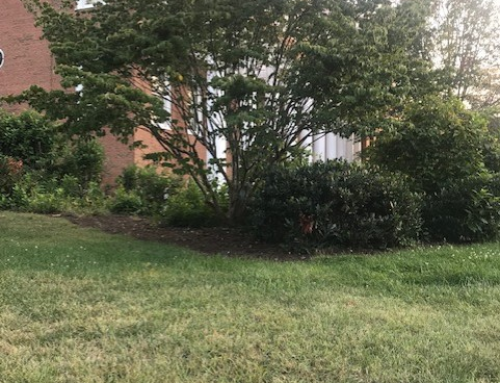
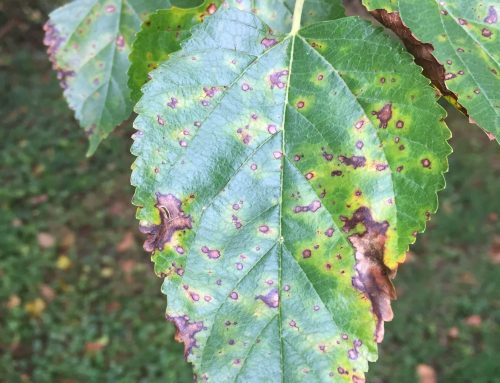
The lichen on the tree looks like the lichen I’m watching for one of my objects! I believe it’s foliose lichen, it seems to be very common around here.
That’s awesome that you got to observe monarchs migrating. Great adaptation to mention!